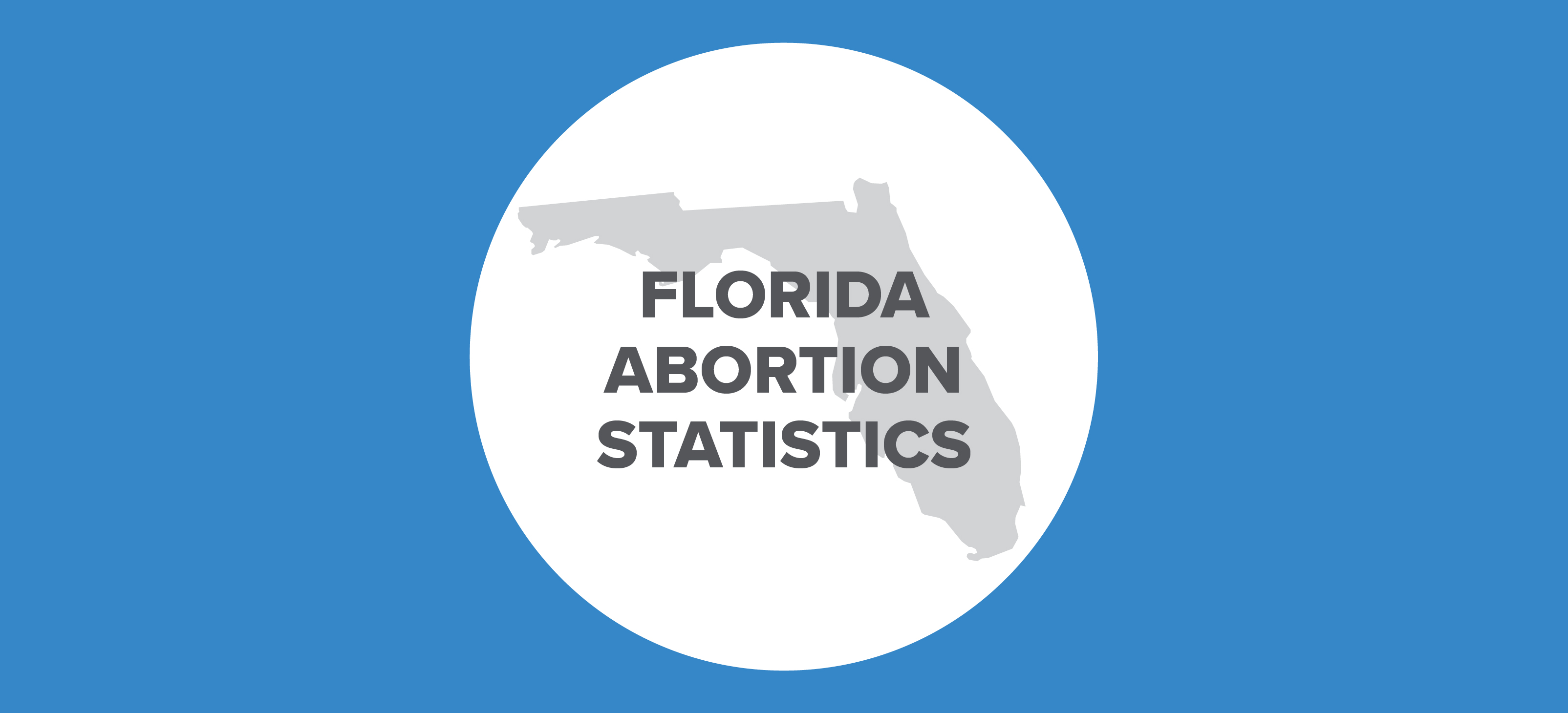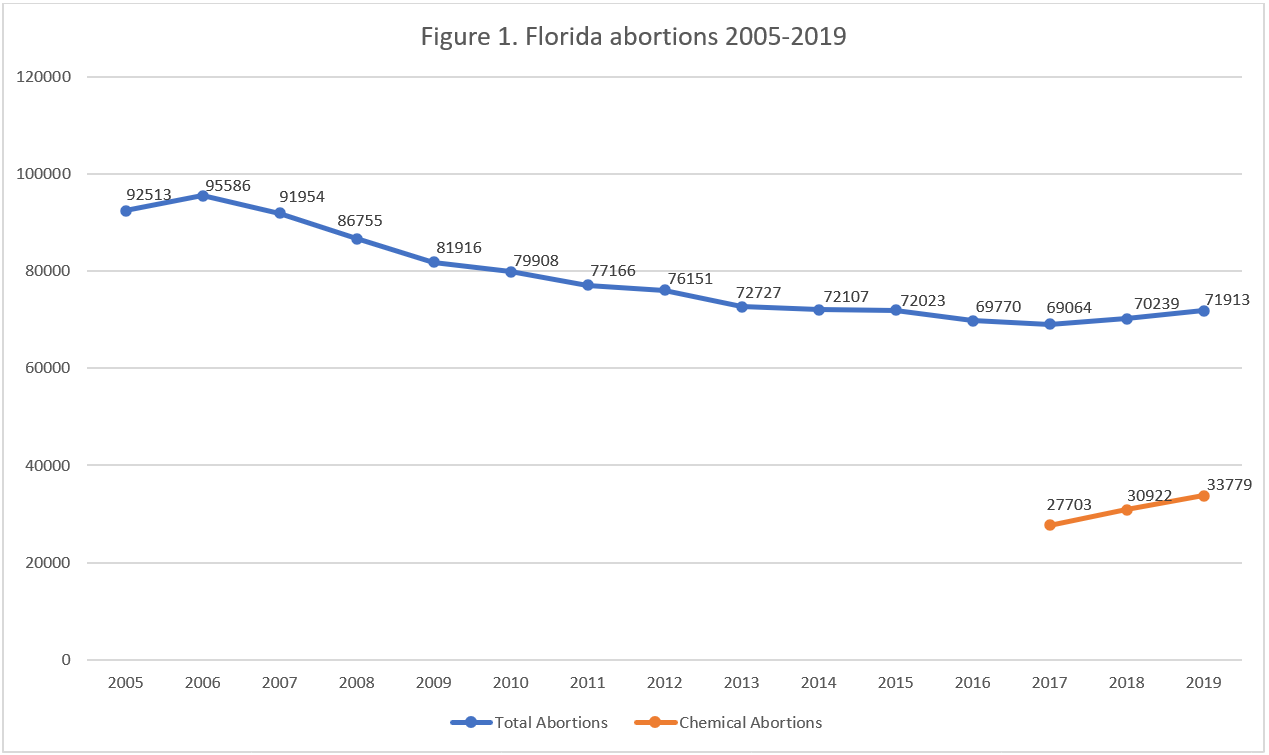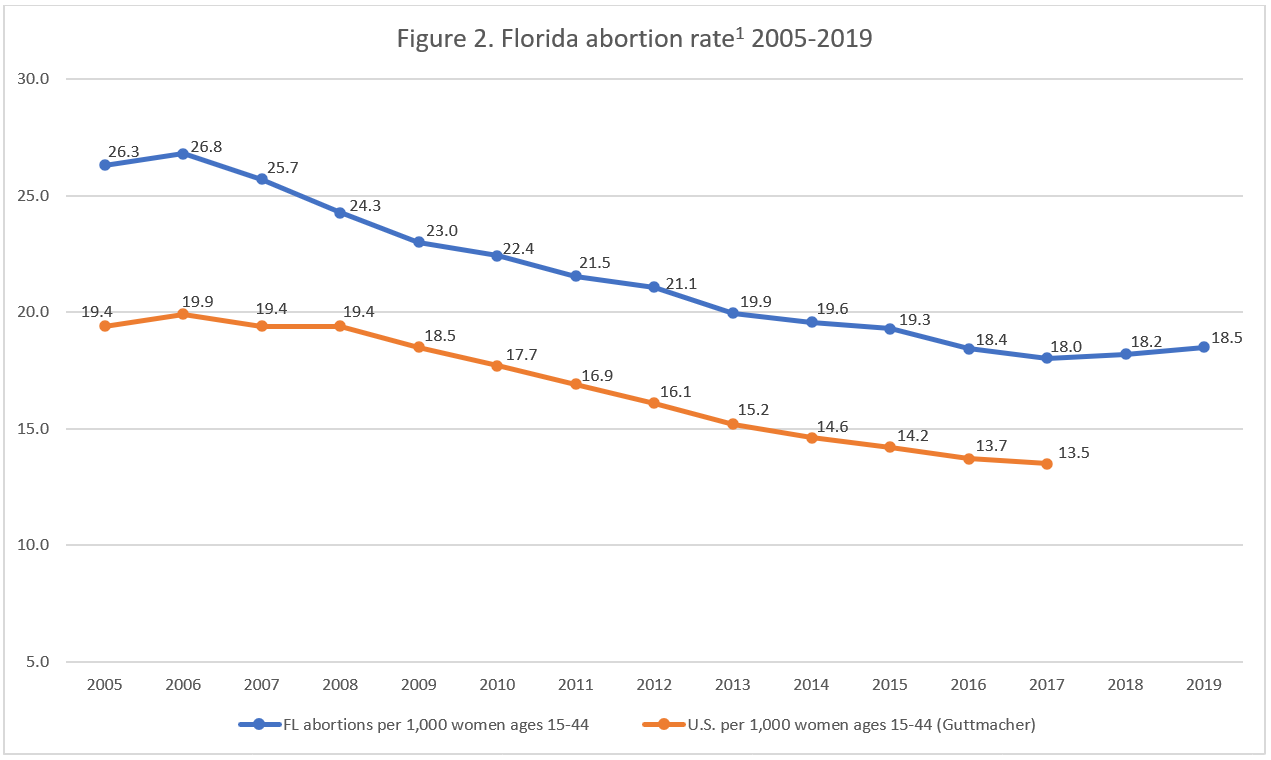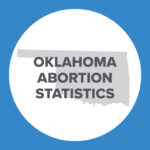Abortion Reporting: Florida (2019)

Florida was one of the first states to release 2019 abortion statistics and made its entire 2019 report available to the Charlotte Lozier Institute in June 2020.
Changes in Florida Abortions, 2018-2019

The report does not include information on Planned Parenthood’s Florida abortion market share.
Abortion Totals and Trends
There were 71,913 abortions reported in Florida in 2019. This represents an increase of two percent from 2018 and marks the second year in a row that Florida abortions have increased after a decade of decline. Chemical abortions rose by nine percent between 2018 and 2019. Since 2017, when Florida first began to collect data on the types of abortion procedures used in the state, chemical abortions have increased by 22 percent, and in 2019, chemical abortions composed 47 percent of all abortions reported in Florida. The Charlotte Lozier Institute (CLI) estimates that Florida’s 2019 abortion rate was 18.6 abortions per 1,000 women of childbearing age, up two percent from 2018 and higher than the national rate (Fig. 2).
State Report Summary
Florida publishes some of its abortion reporting tables on the website of the Florida Agency for Health Care Administration (AHCA). The rest of the 2019 reporting tables were provided to CLI upon request. In 2019, the vast majority of abortions occurring in Florida were performed on Florida residents (97 percent). Just three percent were on women from outside the state, of whom more than half traveled from Georgia.
Fifty-five percent of Florida abortions were on women in their twenties; 26 percent were on women ages 20 to 24 and 29 percent on women ages 25 to 29. A third of the abortions were performed on women in their thirties, and four percent were on women age 40 or older. Seven percent of the abortions were on girls under the age of 20. One percent of the abortions were on women of unknown ages.
In 2019, 48 percent of Florida abortions were performed on white women. Thirty-five percent of the abortions were on black women, and 11 percent were on women of other races. Seven percent were performed on women whose race was not reported. CLI estimates that in 2019, Florida’s black abortion rate of 30.2 was two-and-a-half times higher than the white abortion rate of 12.0. Sixty-six percent of the abortions were on non-Hispanic women, 28 percent on Hispanic women, and seven percent on women of unknown ethnicity.
Seventy-three percent of Florida abortions were on unmarried women, compared to 14 percent on married women and 13 percent on women of unknown marital status. Well over half (58 percent) were on women who had no previous abortions, 24 percent on women with one previous abortion, and 18 percent on women who had two or more prior abortions. In comparison, just 38 percent of the abortions reported in Florida were on women who had no previous live births. A quarter were on women who had one prior live birth, and 37 percent were on women with more than one.
Florida’s abortion report uses the term “gestational age” to refer to pregnancy measured from the date of fertilization (post-fertilization age), even though the term gestational age is usually used to measure pregnancy from the start of a woman’s last menstrual period. Florida’s abortion reporting handbook instructs abortion facilities to report pregnancy as measured from fertilization and notes that “Because the Agency is not collecting an estimate of gestational age, the method used to determine the date of fertilization (from LMP or ultrasound) is irrelevant and need not be specified.” Post-fertilization age is typically two weeks less than gestational age. In 2019, 73 percent of the abortions were performed at six weeks post-fertilization or earlier. Thirteen percent occurred from seven to eight weeks, and six percent were performed between nine and 10 weeks post-fertilization. Three percent were performed between 11 and 12 weeks, and two percent occurred between 13 and 15 weeks. One-and-a-half percent were performed from 15 to 17 weeks post-fertilization. There were 915 abortions (1.3 percent) performed at 18 weeks post-fertilization, approximately 20 weeks of gestation, or later. Of these, one percent were performed from 18 to 20 weeks, and 0.3 percent were performed at 21 weeks post-fertilization or later.
In 2019, 48 percent of the abortions reported in Florida were curettage procedures, and 47 percent were chemically induced. There were eight hysterectomy or hysterotomy abortions. Five percent of the abortions were performed using other or unreported methods.
The reasons for the abortions performed in 2019 were similar to those reported the previous year. Three-quarters of the abortions were categorized as elective, while 21 percent were performed for social or economic reasons and 1.5 percent because of the mother’s emotional or psychological health. 1.4 percent were performed because of the mother’s physical health and one percent because the unborn baby had an abnormality. There were 163 abortions performed because of a risk to the mother’s life, 119 abortions because the pregnancy resulted from rape, and 10 because the pregnancy resulted from incest.
Two babies were reported to have been born alive during abortions in 2019. The report does not indicate the outcomes for these babies, and AHCA has informed CLI that no additional information is available on babies who survived abortions. Between 2013, when Florida enacted its Infants Born Alive Act to protect babies who survive abortions, and 2019, 23 babies were reported to have been born alive during abortions in Florida.
Parental Consent
In 2020, Florida enacted a law to require parental consent before an abortion may be performed on a minor. The bill failed to make it out of committee in 2019, but Governor DeSantis urged the Florida legislature to take it up again during the 2020 session. Florida’s original parental consent law, enacted in 1979, was overturned by the state supreme court in 1989. To preserve its constitutionality, the current law provides for a process by which a minor may obtain a judicial waiver to the parental consent requirement.
In addition to the parental consent law, Florida requires that a minor’s parent or guardian be notified before a minor obtains an abortion. The parental notification law was overturned by the state supreme court in 2003 but reinstated by a constitutional amendment in 2004.
In 2019, there were 1,408 abortions performed on girls under the age of 18. Of these, 1,290 were on girls ages 15 to 17, and 118 were on girls under the age of 15.
State Ranking
CLI’s 2016 survey of abortion reporting across the United States ranked Florida’s state reporting at 40th best. In 2017, Florida made major improvements to its abortion reporting system, but the state could take further steps to strengthen its reporting even more. Florida could collect and publish more information on the babies who are born alive during abortions, including the type of care provided to them and whether they survive for a lengthy period of time. The Sunshine State could collect and report data on complications caused by abortion, particularly chemical abortions, and report the reasons for late-term abortions. Additionally, Florida could make all its abortion reporting tables available online.


- Rates were calculated by CLI using population estimates from the United States Census Bureau. The rates were calculated using the following formula: (total number of abortions performed in Florida ÷ number of resident women ages 15-44) x 1,000. Rates may differ slightly from previous CLI articles due to revised population estimates and abortion totals.
Click here to view reporting from:a class=”a-reporting” href=”https://lozierinstitute.org/abortion-reporting-florida-2023/”>2023201222021202020182017

























